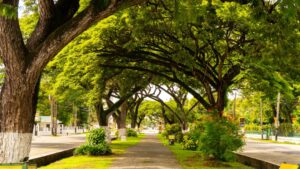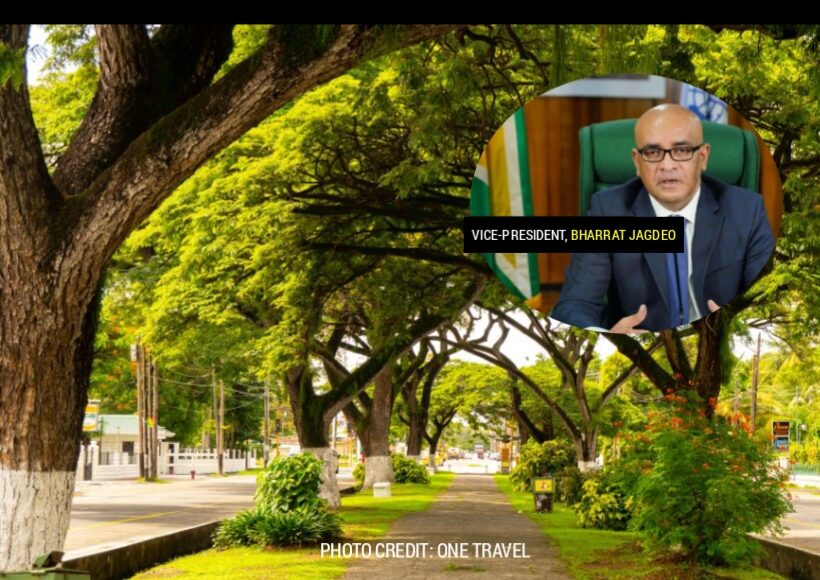By: Sueann Wickham
In the relentless pursuit of economic growth, nations worldwide have often turned to the exploitation of natural resources to fuel development. In many cases, the extraction of oil and gas resources has been a cornerstone of this strategy, leading to extensive infrastructural development in regions rich in these commodities. However, this approach comes with a significant cost, particularly concerning the preservation of green spaces and the ecological balance they support.
Countries such as Norway and Costa Rica have exemplified the possibility of balancing infrastructure development with the preservation of green spaces. Norway, despite being one of Europe’s largest oil producers, has implemented stringent environmental regulations and invested heavily in conservation efforts. As a result, the country boasts pristine landscapes, thriving wildlife populations, and a high quality of life for its citizens.
On the other hand, nations like Nigeria and Venezuela have struggled to mitigate the adverse effects of oil and gas development on their natural environments. Rampant deforestation, habitat destruction, and pollution have plagued these regions, leading to the loss of biodiversity, degradation of ecosystems, and detrimental impacts on public health.
Amidst this global discourse, Guyana finds itself at a critical juncture. Endowed with vast oil reserves discovered off the Stabroek Block in 2015, the country stands on the precipice of newfound wealth and development. However, as infrastructure projects proliferate to support the burgeoning oil and gas industry, concerns have been mounting over the potential ramifications for Guyana’s rich biodiversity and pristine landscapes.
With over 80 percent of its landmass covered in forest, Guyana is home to some of the most intact and biodiverse ecosystems in the world. The country’s rainforests not only harbor unique species of flora and fauna but also play a crucial role in global climate regulation, carbon sequestration, and maintaining ecological balance.
Regarding concerns surrounding the preservation of green spaces, the Government of Guyana has come forth to note that it has taken proactive steps to revitalize and maintain such areas, particularly in the country’s capital city, Georgetown. According to Bharrat Jagdeo, General Secretary of the People’s Progressive Party/Civic (PPP/C), the government has embarked on several beautification projects aimed at promoting green and leisure spaces in communities.
During a recent press conference, Jagdeo highlighted the government’s commitment to enhancing recreational facilities across Georgetown. He revealed that following meetings with citizens, 34 playgrounds across the city were identified for rehabilitation works. These efforts are part of a broader initiative to create inviting and sustainable public spaces for residents to enjoy.

“We got our engineers to go and identify all the grounds in the city, every single ground from Agricola all the way to Cummings Lodge,” Jagdeo noted. “We said we are going to raise the grounds; we said we are going to fence the grounds if they are in a state of disrepair.” Additionally, plans include installing lighting and constructing buildings to provide public facilities and walkways around the playgrounds.
Jagdeo emphasized that the government’s focus on recreational facilities aligns with its broader vision for the city’s development. “Recreational facilities in the city have been a priority,” he affirmed. “The city will be greener and cleaner.”
Simultaneously, Jagdeo noted that the government is pursuing development projects that complement the city’s economic growth. This dual approach he said, underscores the importance of balancing environmental preservation with socio-economic progress, reflecting a nuanced understanding of the interconnectedness between infrastructure development, green spaces, and community well-being.
These revelations from Jagdeo were in response to criticisms of the construction of a hotel on two recreational grounds Carifesta Avenue by Qatari Assets Group, which is supposedly encroaching upon “green spaces” within the city. Jagdeo maintained that the project is part of the government’s broader vision for urban development, insisting that it does not represent a diminishing of green or recreational spaces.
The role of international partnerships and civil society
Recognizing the global significance of Guyana’s environmental stewardship, international partners and civil society organizations have a crucial role to play in supporting sustainable development initiatives. Through technical assistance, capacity-building programs, and financial support, these stakeholders can empower Guyana to effectively manage its natural resources while promoting inclusive and equitable growth.
One such endeavor is the existing Guyana REDD+ Investment Fund (GRIF), a partnership with Norway aimed at curbing emissions from deforestation and promoting sustainable forest management. The GRIF channels financial resources into conservation and development projects across Guyana.
Supported by the Global Environment Facility (GEF), the Guyana Protected Areas System Project (GPASP) strengthens the management of protected areas, enhances biodiversity conservation, and advocates for sustainable land use practices. This initiative underscores the importance of safeguarding Guyana’s natural habitats for future generations.
Additionally, organizations like Conservation International (CI) play a pivotal role in Guyana’s conservation efforts. Through collaborative endeavors with local communities and governmental agencies, CI works to establish protected areas, protect biodiversity hotspots, and promote sustainable resource management practices.
The United Nations Development Programme (UNDP)also contributes to Guyana’s environmental sustainability. With a focus on ecosystem restoration and climate resilience, UNDP initiatives often support the country’s efforts to adapt to climate change and mitigate environmental risks.
Furthermore, the Inter-American Development Bank (IDB) finances projects aimed at enhancing environmental governance, managing natural resources, and building climate resilience in Guyana. Such investments underscore the importance of international cooperation in addressing environmental challenges.
Furthermore, fostering dialogue and collaboration among government agencies, indigenous communities, industry stakeholders, and environmental advocates is no doubt essential for achieving consensus on development priorities and ensuring that the voices of all stakeholders are heard.
Leveraging technology for environmental monitoring and enforcement
In an era of rapid technological advancement, Guyana can leverage innovative tools and techniques for environmental monitoring and enforcement. Remote sensing technologies, satellite imagery, and geographic information systems (GIS) offer powerful means of tracking land-use changes, identifying deforestation hotspots, and monitoring the impact of infrastructure projects on green spaces.
By harnessing the power of data analytics and machine learning algorithms, authorities such as the Environmental Protection Agency (EPA) can enhance their capacity to detect and deter illegal logging, mining, and other activities that threaten the integrity of Guyana’s ecosystems. Moreover, by promoting transparency and accountability, technology can empower local communities to actively participate in monitoring efforts and hold accountable those responsible for environmental degradation.
Furthermore, promoting ecotourism initiatives that showcase Guyana’s rich biodiversity and cultural heritage can generate revenue streams that support conservation efforts while fostering greater appreciation for the intrinsic value of green spaces. Notably this is already being done, and by embracing a holistic approach to development that integrates economic, social, and environmental considerations, Guyana can unlock the full potential of its natural capital while safeguarding it for future generations.
The nexus between infrastructure development, oil and gas extraction, and the preservation of green spaces presents both challenges and opportunities for Guyana and the global community. As the country embarks on its journey toward sustainable development, it must heed the lessons of history and learn from the experiences of other nations such as Norway and Costa Rica, and the failures of other nations.
Ultimately, the fate of Guyana’s green spaces is not only a matter of national importance but also a shared responsibility of humanity as stewards of the planet. Only by working together it can be ensured that future generations inherit a world where nature thrives, communities prosper, and sustainable development prevails.











